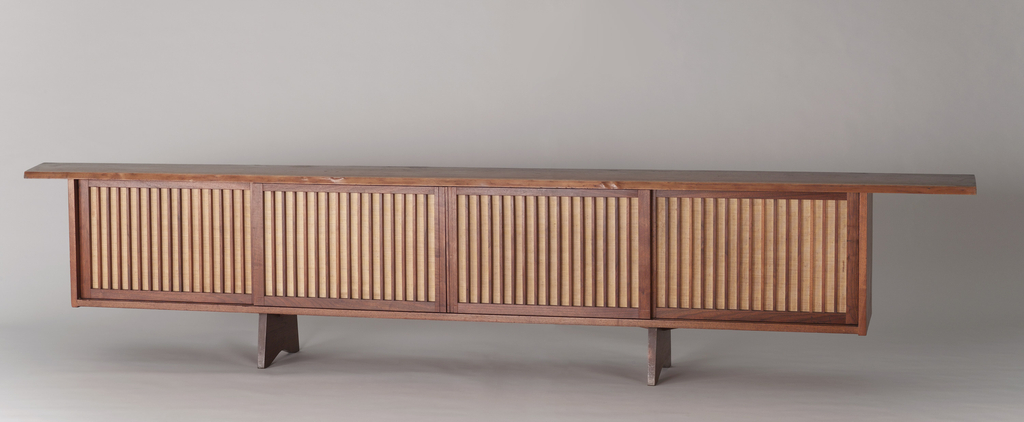One of the twentieth century’s most renowned furniture makers, George Nakashima (1905–1990) is remembered for his reverence for natural materials. With its silky, nuanced grain and soft, contoured edges, this massive sideboard embodies his profound interest in the organic expressiveness of wood.
Nakashima was born in 1905 in Spokane, Washington to first-generation Japanese immigrants. After earning a master’s degree in architecture from MIT, he traveled and worked abroad, spending time in France, North Africa, Japan, and India, before returning to the United States in 1940. Based in Seattle, he began teaching woodworking while making his own furniture. Like other Americans of Japanese ancestry, Nakashima, along with his wife Marion and newborn daughter Mira were forcibly relocated to an internment camp in Hunt, Idaho starting in 1942. While imprisoned, he met master carpenter Gentaro Kenneth Hikogawa, who taught him traditional Japanese methods of joinery and the proper use of Japanese hand tools. After a former employer sponsored Nakashima’s release in 1943, he settled in New Hope, Pennsylvania, eventually starting a studio. Merging Japanese aesthetics and woodworking with his intimate knowledge of European modernism—he was a great fan of Le Corbusier—Nakashima created an innovative body of work significant to American postwar design in its consummate attention to craft and reverence for materials.
Nakashima’s great respect for wood, nature, and spirituality guided his practice. Inspired by cultural concepts he encountered on his travels, particularly in India and Japan, he said: “We work this material to fulfill the yearning of nature to find destiny, to give this absolute inanimate object a second life, to release its richness…to read its history in life.”[1] He believed that wood was alive, so constantly reacting, always influenced by weather and other environmental conditions. Each piece of wood that he used in a piece of furniture needed to be understood so that it would function properly.
This sideboard was commissioned in 1958 by Natalie Epstein and her husband for their Long Island home. Nakashima worked with them to design this capacious storage unit, and his notes are still clear on his design drawing, which the museum acquired with the sideboard. The simple form emphasizes the materials, walnut wood and a contrasting light-colored woven pandana cloth behind the vertical slats of the rectangular sliding door panels. After more than sixty years since it was made, the piece still draws the viewer in to enjoy the natural materials on many levels.

Drawing: Design for Sideboard. George Nakashima,1958.Graphite on cream paper, 15 x 22.8 cm (5 7/8 in. x 9 in.). 2006-18-2.
(Updated March 24, 2021)
[1] Moonan, Wendy. “Antiques: A Reverence for Wood and Nature,” New York Times, November 7, 2003. http://www.nytimes.com/2003/11/07/books/antiques-a-reverence-for-wood-and-nature.html.
